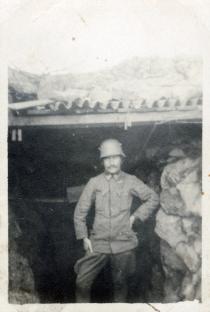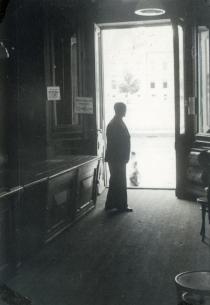This is my father Jeno Moskovits on the battlefield, but I don't know exactly where. He is in a fire-trench. I don't know where this picture came from, and it doesn't have a date on it. It was taken during World War I.
My father was born in 1891 in Kiralydaroc as the only child of the family. Unfortunately I don't know anything about his childhood. He left home at a very early age and graduated from the teacher training college in Budapest before World War I, sometime in the early 1910s.
Then he joined the army and during World War I he fought on the Italian and the Russian fronts. He was a reserve lieutenant there. He was wounded; a bullet flew by his ear and tore off a small part of it.
He ended up in hospital. He had some military medals and I think he had four decorations, including a silver medal, and another one called Palmed Military Cross with Swords.
Thanks to these decorations, during the Hungarian times, in 1940, when the Hungarians came in and the numerus clausus was already effective, one could have some advantages, such as being put further up admission lists, if one's father had fought in the war and won decorations.
My father didn't tell us too much about the teacher training college. I know he graduated with good grades, and after that, when it was the Romanian era after 1918 [following the Trianon Peace Treaty], he had to, as they called it then, nostrificate his diploma.
I don't know how he arranged to be acknowledged by the Romanian authorities. What I heard is that he was a teacher in some villages nearby, Alsoszopor and Felsoszopor, then he was transferred to Zilah and taught there. He got married in 1920.
He and my mother, Jolan Klein, were originally from the same village; he was courting her even before he went to the front. I remember we had quite a few army postcards from that period he'd sent from the battlefield to his parents and to my mother, but after our deportation they disappeared, of course.
We, kids, brought them out very often and looked at them because we loved the idea that they came from the front, and that was sensational for us. They had a pinkish color, bore the post-mark on them and were bundled together.






























